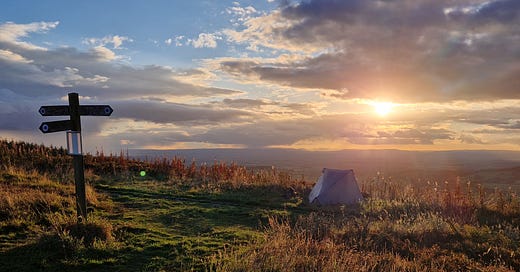In September, I set off to walk from my hometown of Nottingham back to Newcastle, where I’ve lived most of my life; a distance of around 220 miles. I wanted to discover if I could safely wild camp across lowland England; learn about the people, places and wildlife between my two ‘home’ cities; and undertake my longest backpacking adventure so far.
The most common reaction I received when planning the trip was, “You’re not walking up the A1, are you?!” as if that was the only logical route. And, for the most part, it is. The drive from Nottingham to Newcastle is 160 miles due north, most of which is on the A1 motorway, and fast roads distort our view of time and space. I am not immune.
If I had closed my eyes before the trip and tried visualising the map, it would have looked like an elongated egg timer with a bulbous top and bottom around Nottingham and Newcastle, but with a long, skinny, ill-defined middle representing the places in between (North East Lincolnshire, Yorkshire, and County Durham). This trip would right that wrong by filling in the gaps, leaving an unbroken chain of footprints and memories from home to home, like a cartographical pilgrimage. It would be a throwback to the days before the motorcar, railways, and even the bicycle: ‘A Canny Walk Home’.
Memory Lane
I began early one morning in Nottingham’s Old Market Square after visiting family nearby. I reached out to touch the rough limestone nose of the ‘Left Lion’ on the steps of the Council House. We always met friends at the statue of the left lion when I was a child, never the right; after all, ‘Left Lion’ illiterates, whereas ‘Right Lion’ just leaves one feeling cold. In the days before mobile phones, it was important to be specific about arrangements… and perhaps a little rhetorical.
The sky was grey, and the imperious lion (who’s proper name is Agamemnon) glowered at the humdrum scene: pigeons flocked, trams trundled, commuters plodded, and a large construction lorry beeped as it reversed from the centre of the square, removing staging from an event. This was the same place where, back in the 1980s, a large concrete pond stood with a fountain in the middle that was usually full of bubble bath or hair dye. A thrilling sight for a young boy, and I still mourn their removal when the square was modernised. Two young girls ran up to the lion and reached up to touch his face. “Don’t touch is nose – it’l ave yr ‘and off”, their dad called after them in a Nottinghamshire dialect whilst pushing a pram over the flagstones. Much giggling ensued.
I bid farewell to Agamemnon, “Tarrah midduk”, weaved my way through the commuters, past the men’s clothes shop on the corner (where half a lifetime ago, I was employed to fold shirts and knitwear during the holidays) up to what remains of Nottingham castle to be reunited with the fine statue of Robin Hood and his stringless bow. Near the statue is an information board describing Nottingham as the strategic ‘Gateway to the North’ for the kings of England following the Norman conquest. In those days, ‘THE KING’S WAY’ beat a path from Nottingham to York through Sherwood Forest, a route I would roughly follow for the first two days. On my first night, I would camp in the ominously named Thieves Wood, so called because of its reputation for highwaymen. Aged 49, I would finally live out a childhood fantasy by wild camping in Sherwood Forest. I imagined sharing a camp fire with Robin Hood and his Merry Men whilst discussing how best to evade the evil Sheriff of Nottingham. Hashtag ‘Sherwood’.
I continued north, passing other significant landmarks from my childhood: Newcastle Circus, where I paused to rest on the same bench where my wife, Tracy, and I began courting in 1991 and had our first kiss; my old castle-like school, fronted by its war memorial of a soldier giving a victory salute; and the Forest Recreation Ground where we use to go cross-country running and where Goose Fair is held every autumn. I still have vivid memories of walking down through ‘The Forest’ with my parents, the thrill of glimpsing twinkly lights through the trees and inhaling the frosty air. The heady fairground aroma of hotdogs and candy floss laced with diesel oil drifted up the hill to greet us.
Beyond ‘The Forest’, I continued through the suburbs of Nottingham before emerging into the afforested countryside: a patchy landscape of acorn-dispersing jays, old stately homes, abandoned coal mines, and abundant pig farms, otherwise known as ‘The Dukeries’.
CONTINUE READING: PART 2






